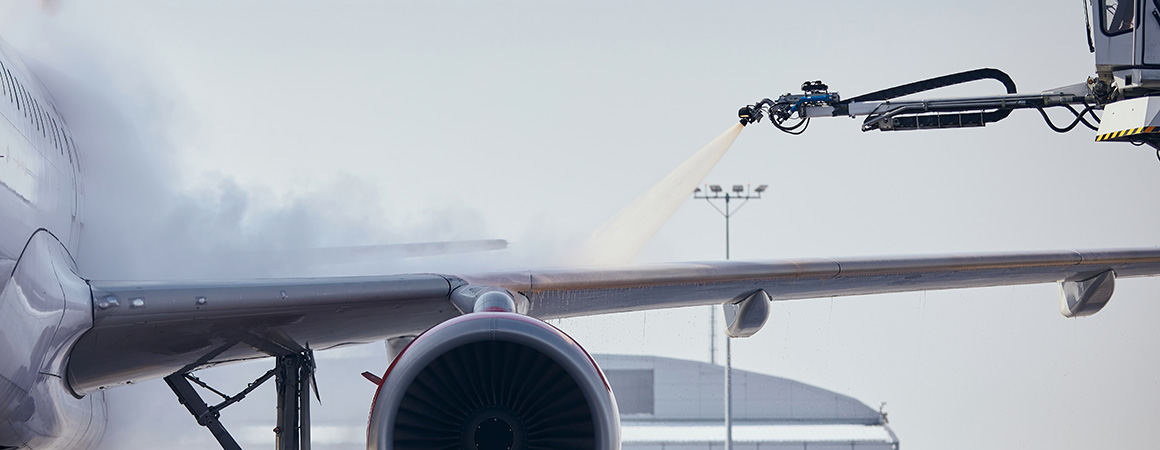No Ice Allowed:
Deicing to Ensure Safe Travels and Sustainability
Brooms and hot water. Mechanical scrapers. Electric heaters. Since the dawn of aviation, airplane crews have used a variety of techniques to keep the wings of planes ice- and snow-free. But one approach soars above the rest: coating the surfaces of the wings and the fuselage with a liquid that will delay freezing.
Keeping a plane in the sky means ensuring that nothing interferes with an aerofoil’s lift, including ice and snow, which can form on the metal surfaces of an airplane within seconds. Even the smallest of ice deposits – the texture of sandpaper – on top of a plane’s wings and tail, are enough to cause aerodynamic stall, a condition that can lead to loss of control.
Ice formation on planes is responsible for almost 10 percent of all fatal air crashes, according to the US National Aeronautics and Space Agency (NASA). And countless flights are canceled each winter due to icing on aircrafts.
"This recycling process has helped some airports reduce the amount of “new” fluids that need to be purchased each winter season by up to 60 percent."
Not a One-Size-Fits-All Solution
Deicing is a process in which a fire truck-like vehicle hoses down all surfaces of the plane with hot fluids that remove any snow and ice that has already formed. These fluids most commonly consist of glycol, a kind of alcohol with a low freezing point and water. As an additional step in very adverse conditions, an anti-icing solution that forms a protective viscous layer is sprayed to prevent any additional snow and ice build up.
But deicers aren’t a one-size-fits-all kind of product. Clariant has developed a variety of deicing fluids that can accommodate different weather conditions, varying lengths of time the fluids must stay on an airplane and the logistics of the particular airports deploying them. They also have good environmental profiles compared to conventional deicing products made from ethylene glycol, which contribute to groundwater pollution.
Clariant’s Safewing™ fluids, used in international airports around the globe, are offered in a variety of formulas. Among the most popular is the “SafeWing MP I 1938 Eco (80)”, which consists of 80 percent propylene glycol. These fluids have special properties which help minimize the production of foam that might obstruct operations, making it easier to see the cleaned wing surface and help protect against environmental corrosion.
The Safewing line of fluids also include a variety of anti-icing solutions known for their extended holdover times (HOT), delaying the reformation of ice before a plane’s takeoff.

Environmental Impacts
Deicers must also ensure safer travel for people while minimizing harm to the planet. Recognizing that at least some of the fluid sprayed onto an aircraft will fall to the ground, Clariant’s deicers are biodegradable.
Increasingly, however, the areas in which deicing takes place feature dedicated drains that can collect used fluids. Clariant leverages these drains and, in addition to manufacturing the deicing product, also offers a recycling process that captures and recycles the glycol so that new deicing fluids can be produced on the airport premises. This recycling process has helped some airports reduce the amount of “new” fluids that need to be purchased each winter season by up to 60 percent. Recycling of these fluids can also help reduce an airport’s carbon footprint – one airport reported a decrease of 5,000 metric tons of carbon dioxide produced per year. With more sustainable airports and safer flying, it’s a win on the ground and in the air.

